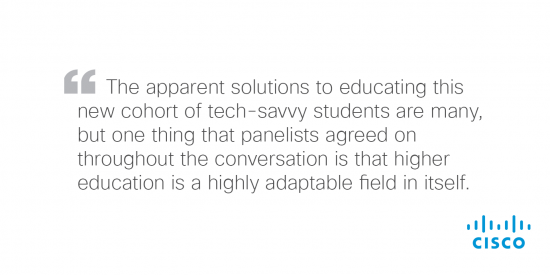2016 is shaping up to be one of the most exciting times for higher education in Australia, with universities taking an active and important role in digitizing not only campuses but the wider Australian economy. If Australia is to be a genuine force in the digital economy, then universities will need to play several roles as sources of innovation and IP, talent managers and hubs of collaboration.
From a talent perspective, universities must educate our future workforce to be prepared to innovate and thrive in a digital world, not just to be domain specialists. Universities also have an important role to help the industry navigate the digital transformation by bringing a broad range of knowledge and IP to the table.
 With this context in mind, and wearing my dual hats as both the Vice President, Australia New Zealand for Cisco and President of B/HERT (Business & Higher Education Roundtable), it was my great pleasure to partner with the University of Queensland in February to host the Presidents’ Conversation in Brisbane.
With this context in mind, and wearing my dual hats as both the Vice President, Australia New Zealand for Cisco and President of B/HERT (Business & Higher Education Roundtable), it was my great pleasure to partner with the University of Queensland in February to host the Presidents’ Conversation in Brisbane.
This was Cisco’s second time convening a Presidents’ Conversation, following the first event which was held in San Jose, California in 2013. The Chatham House rules-style conference brought together 12 university presidents and vice-chancellors from around the world to discuss what digitization means for the economy, and the role and opportunity for universities.

The teaching and learning function of universities has been particularly transformed by digitization. According to a recent McKinsey report, there is still a disconnect between what educational providers and employers perceive to be necessary in terms of skills for the workforce. 72 percent of educational providers think graduates have the necessary skills needed for employment, versus 39 percent of employers. This creates another collaboration opportunity, where business employers need to do more to identify what skills are needed long-term, and for universities to evolve the curriculum accordingly.
So what are the challenges that universities face today in getting students ready for jobs that perhaps don’t even exist yet? And how can they offer an educational experience that is synonymous with the world that “digital natives” have been born into?
The idea that we’re living in an “attention economy” brings with it a range of challenges, given that lecture halls have been the de-facto areas for knowledge transfer in universities, whereas human attention drops off sharply after seven minutes of concentration.

In addition to the formal aspects of education for an agile, innovative, and resilient workforce and society, universities have an important role as ‘ideal connectors,’ within the digital eco-system. One recent and clear example of this type of collaborative behavior is Cisco’s partnership with both Curtin University in Perth as the site of the first Cisco Innovation Centre in Australia, and our partnership with the University of New South Wales in Sydney for the second Australian site for Cisco’s Innovation Centre, which was formally launched last month.
The Presidents’ Conversation was an excellent forum for global higher education leaders to discuss changes in education and it’s pleasing that this conversation was held on Australian turf, as Australia has the capacity to innovate at scale, and capture the benefits of digitization as a prime exporter of higher education.

Key insights from the Presidents’ Conversation:
- Universities must shift the paradigm that rather than being standalone institutions, they are active and important participants within a digital ecosystem. This requires a mind-set of collaboration and open partnerships so that universities can help to co-create the future and act as advocates for new theories and technologies as they come to life.
- As educators, universities have the capability, and therefore the onus to put frameworks in place for a new, exciting and at times challenging workforce proposition. To help create a citizenry that has been educated to enable change, cope with change, be resilient, innovate and thrive.
- Overcome internal bureaucracy to be an important part of the innovation eco-system – creating and fostering innovation within, so that universities are changing and adapting at the same rate as the society, government and enterprise.
- All universities have a massive incentive and need to develop and grow their own digital capabilities (including infrastructure, people & programs), as a platform for innovation.


CONNECT WITH US